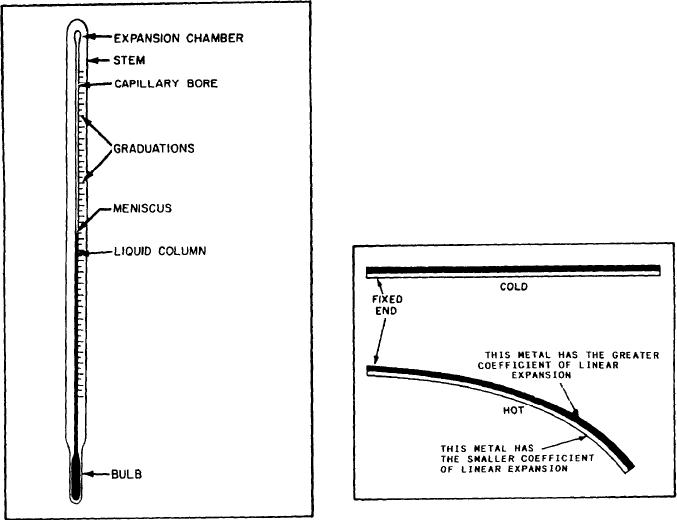
reading. The space above the liquid in this type
has a known relationship to temperature changes.
of thermometer may be a vacuum or filled with
The types of expansion thermometers discussed
an inert gas such as nitrogen, argon, or carbon
here are (1) liquid-in-glass thermometers, (2) bi-
dioxide.
metallic expansion thermometers, and (3) filled-
The capillary bore may be either round or
system thermometers.
elliptical. In any case, it is very small, so a
relatively small expansion or contraction of the
Liquid-in-Glass Thermometers
liquid causes a relatively large change in the
position of the liquid in the capillary tube.
Liquid-in-glass thermometers are probably the
Although the capillary bore itself is very small in
oldest, the simplest, and the most widely used
diameter, the walls of the capillary tube are quite
devices for measuring temperature. A liquid-in-
thick. Most liquid-in-glass thermometers have an
glass thermometer (fig. 5-1) has a bulb and a very
expansion chamber at the top of the bore to
fine bore capillary tube containing alcohol, or
provide a margin of safety for the instrument if
some other liquid that expands uniformly as the
it should accidentally be overheated.
temperature rises or contracts uniformly as the
Liquid-in-glass thermometers may have
temperature falls. The selection of liquid is based
graduations etched directly on the glass stem or
on the temperature range in which the ther-
placed on a separate strip of material located
mometer is to be used.
behind the stem. Many thermometers used in ship-
Almost all liquid-in-glass thermometers are
board engineering plants have the graduations
sealed so atmospheric pressure does not affect the
marked on a separate strip; this type is generally
easier to read than the type that has the
graduations marked directly on the stem.
You will seldom find liquid-in-glass ther-
mometers on gas turbine ships. As a GSE/GSM,
you may still find this type of thermometer in use
in the oil and water test lab for analytical tests
on fuel, oil, and water.
Bimetallic Expansion Thermometer
Bimetallic expansion thermometers make use
of different metals having different coefficients
of linear expansion. The essential element in a
Figure 5-2.--Effect of unequal expansion of a bimetallic
strip.
Figure 5-1.--Liquid-in-glass thermometer.
5-2

